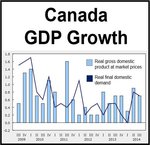Canada’s GDP grew by 2.8% annually in the third quarter, according to a Statistics Canada report issued on Friday, which was considerably higher than economists’ expectations. However, the recent meltdown in oil prices is likely to depress figures for the fourth quarter.
In just one month, the economy expanded by 0.4% in September.
With oil prices plummeting by more than 30% since June’s peak to a four-year low, Canada’s federal and provincial governments are reconsidering their forthcoming spending plans.
While some analysts may have expected the Bank of Canada to bring forward its interest rate rising strategy, others say the fall in energy prices is more likely to encourage the central bank to push those considerations further into the future.
There is virtually unanimous agreement among analysts that when the Bank of Canada policymakers meet next week, they will decide to keep interest rates at their current record-low levels.
Chart Source: “Gross domestic product and final domestic demand,” Statistics Canada.
Production growth and capital spending will fall dramatically in the next quarter after the steep decline in oil prices.
Although third-quarter GDP growth was greater than expected, it was smaller than the second quarter’s 3.6%.
According to Statistics Canada, real GDP grew by 0.7% in the third quarter, after increasing by 0.9% in Q2.
The third quarter expansion was mainly driven by household spending and exports.
At 0.7% growth in Q3, household spending grew at a slower rate than Q2’s 1.1%.
After gaining 4.4% in the second quarter, exports of goods and services in Q3 slowed down to 1.7% growth, while imports increased by 1% in Q3 versus 2.4% in Q2.
The United States’ GDP grew by an even more impressive 3.9% (annually) in the third quarter.


